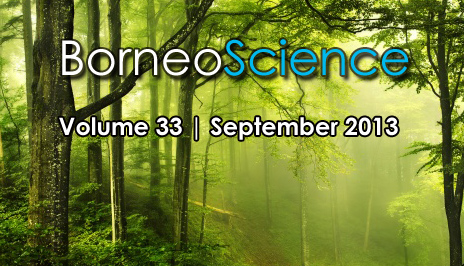Jessie Beliku* & Ejria Saleh
Department of Fisheries-Sabah,
Wisma Pertanian Sabah, Level 4, Block B, Jl. Tasik Luyang,
88624 Kota Kinabalu, Sabah, Malaysia.
Borneo Marine Research Institute,
Universiti Malaysia Sabah, Jalan UMS, 88400 Kota Kinabalu,Sabah, Malaysia.
ABSTRACT. The northern part of Sabah is largely formed by the proposed Tun Mustapha Park (TMP). It is also as a part of Priority Conservation Areas (PCA) in the Malaysian side of Sulu-Sulawesi Marine Ecoregion (SSME) and known as Kudat-Banggi PCA. It has been recognized to be one of globally significant and outstanding in term of marine ecosystems, biodiversity and identified as a route for turtle from the South China Sea to Sulu Sea. Fisheries activities are among the important source of income to coastal communities and have contributed to higher fish and prawn landing in Sabah. The objective of this study is to access fisheries activities and their impact on turtles. The study was carried out through a combination of survey interviews and observation field trips on fishing boats. Interviews were conducted to the main fishing gears (gill nets, shrimp and fish trawl net) used within this area from October 2007 to October 2008 (one year). Onboard observations on gill net fishing field trips near the main town of Banggi, Karakit and coastal villages were carried out between October 2008 and March 2009. As results, 79 fishers operating with gill nets were interviewed while 95 and 41 fishers working on board shrimp trawl net and fish trawl net boats, respectively. There was 116 gill net fishing field trips have been carried out. Turtles were sighted within the fishing grounds and an estimated maximumtotal of 1326.6 turtles per year are accidently catch by fishers. Turtle bycatch was 66.1% from gillnets, 25.9% from fish trawl net and 8% by shrimp trawl. Most turtles reported to be bycatch by fishing gears were located in near shore waters of the islands which are important as fishing ground in TMP. The information gathered from this study support the establishment of the proposed TMP which is importance for the planning and future management plan of the area. Also, the information on status of the fishing gears used by the fishers is needed for marine resources conservation program to the coastal communities.
KEYWORDS. Fisheries activities, turtles, bycatch, fishing ground, Tun Mustapha Park
REFERENCES:
-
Aziz, A. A, 2011. Feasibility Study on Development of a Wind Turbine Energy Generation system for Community Requirements of Pulau Banggi Sabah. Universiti Teknologi Malaysia.
-
Beliku, J., Saleh, E., and Dacho, N. 2012. Fishing Gear and Hot Spot Areas in Proposed Tun Mustapha Park, Kudat, Sabah in International Seminar on Marine Science and Aquaculture Sustainable Development & Management of Aquatic Resources in a Changing Climate on 13-15 March 2012(abstract). Kota Kinabalu, Sabah.
-
Chan, E. H, 1991. Sea Turtle. The State of Nature Conservation in Malaysia. Malayan Nature Society, Kuala Lumpur. P. 120-134.
-
Cooke, F. M. 2003. Living at the Top End: Communities and Natural Resources Use in the Kudat/ Banggi Region of Northern Sabah. WWF Malaysia, Kota Kinabalu.
-
DOFS (Department of Fisheries Sabah), 2006. Kudat Department of Fisheries Data.
-
DOFS (Department of Fisheries Sabah), 2008. Annual Fisheries Statistics 2008. Jabatan Perikanan Sabah. 11 – 134.
-
Hin, C. L. K, 2010. Status of Sea Turtle Resources and Coral Reefs of Maliangin Island Sanctuary, Kudat, Sabah. Master Thesis. Universiti Malaysia Sabah.
-
Lutz, P. L. and Musick, J. A, 1996. The Biology of Sea Turtles. Boca Raton: CRC Press.
-
Lutz, P. L., Musick, J. A. and Wyneken, J, 2003. The biology of Sea Turtle, volume 2. Boca Raton: CRC Press.
-
SEAFDEC (Southeast Asian Fisheries Development Center), 2011. Regional Plan Of Action of Sea Turtles Foraging Habitats in Southeast Asian Waters Report. SEAFDEC.
-
WWF, 2006. Banggi Environmental Awareness Centre (BEAC) – Turtle Project. http://www.panda.org/ accessed on 28 November 2012.

